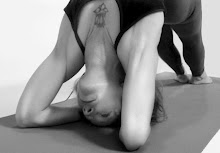Yama Niyama Asana Pranayama Pratyahara Dharana Dhyana Samadhayo 'stavangani
There are eight components of classical Yoga practice:
Yama: very much like the Judeo-Christian Ten Commandments, comprising moral and ethical standards.
1. Ahimsa: non-violence, or non-harming. This was the foundation of Mahatma Gandhi's movement that freed India from the British virtually without a shot. Later, Dr. Martin Luther King, Jr. modeled the civil rights movement after Gandhi's success, as did Ang San Su Chi (I know I am spelling her name wrong...) in Burma and the entire nation of the Phillipines in ousting the Marcos regime. The Christian faith is based upon non-violence, although few "Christians" actually follow it (the Quakers are one sect that take it seriously); Jesus Christ said, "Blessed are the peacemakers..." and "If a man strikes you on the cheek, turn and let him strike you on the other...." and even "Love your enemies!". Sri Pattabhi Jois, guru of the Ashtanga Vinyasa Yoga lineage says of ahimsa that it is "impossible!" to practice. However, dedicated practice in lovingkindness as shown by such persons as the Dalai Lama of Tibet and Thich Nhat Hanh of Viet Nam (who have known so much violence and war in their homelands) prove that perfect ahimsa is possible in humans. One must cultivate an attitude of compassion towards others, even one's enemies, as they must have experienced tremendous sorrow themselves to feel such rage and anger for us. To deny that our enemies feel what we feel is to deny our own humanity.
2. Satya: truth, or right speech/communication. Controlling your speech, thoughts, actions, etc. allows others to respect you and leads to the elimination of malice. One should avoid abusing others with their words, tell the truth unless that truth causes harm or violence to others, and should avoid ridiculing what others hold sacred.
3. Asteya: Not-stealing. Pretty straightforward, includes using something for a different purpose than that intended; misappropriation, breach or trust, mismanagement, misuse....Enron, Tyco, WorldCom, the Business Pages are full of violations of this Yama!
4>Brahmacharya: continence, or moderation. There are different takes on this depending on who you reference. If you are a very traditional yogi(ni) living in an ashram, you are completely celebate. If you are not, according to Pattabhi Jois you may follow the traditional text of Hatha Yoga Pradipika, which lays out the stages of life, where you may be faithful to your spouse during the Householder phase of life and are celibate before and after. The real key here to be moderate. Don't go overboard and you should be okay.
5. Aparigraha: non-greed. Keep things simple, try not to hoard what you don't need - three houses, ten cars, a million pairs of shoes....There are so many families without health insurance, a roof over their heads, food on their plates. Children are going hungry. Some people are one paycheck away from losing everything they have. Others have way more than they could possibly use in their lifetimes. Interesting thing is, money really doesn't make you happy; beyond the basics, once you are secure more will not make you happier. There were two recent lottery stories in the news that illustrated this perfectly: one man in WV won a huge jackpot, didn't know how to handle it and became very unhappy. A woman in CA won a huge jackpot and used the money to help find homes for abandoned babies, or to bury those which died before being rescued - she keeps very little for herself. She is very happy.
Part of the difference may be that she knew who she was before she won the money, therefore it made no difference in her life having more.
Daaiina. And so it is.




